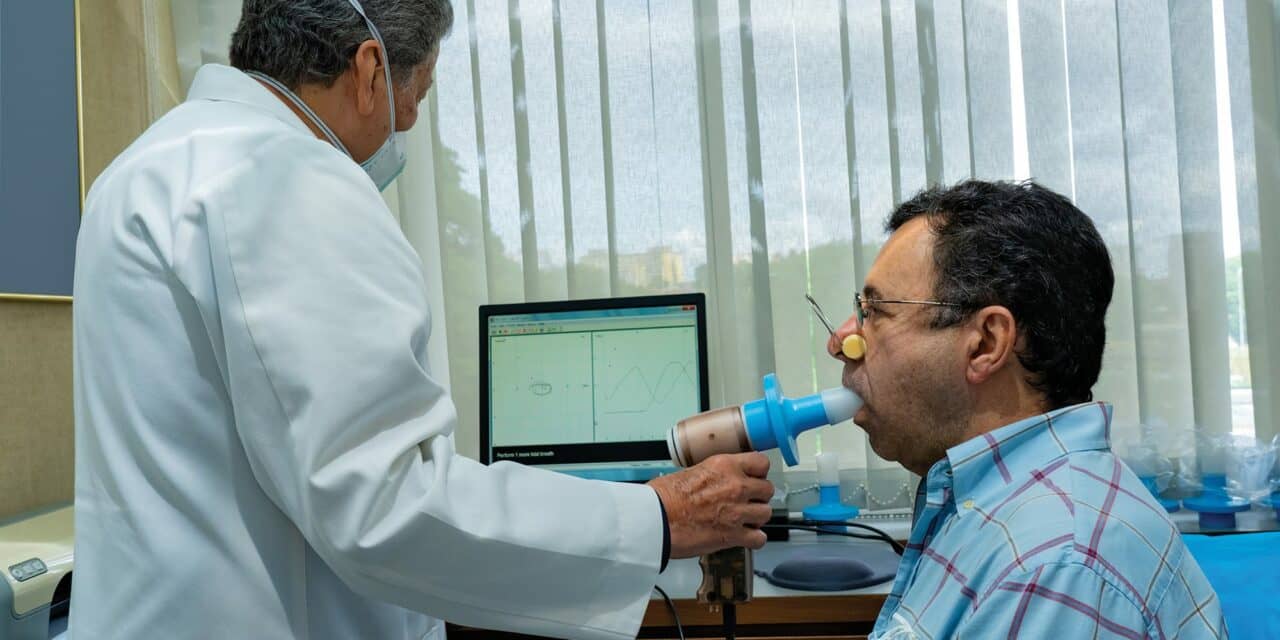But how have spirometry and PFT been affected by COVID-19? RT speaks with executives from leading manufacturers of spirometry and PFT equipment to discuss COVID’s impact on the diagnostics market and to look ahead at technology trends for spirometers.
Pulmonary function testing is an important diagnostic and treatment management tool for chronic lung diseases like asthma, pulmonary fibrosis, and COPD. But how have spirometry and PFT been affected by COVID-19? This month’s Industry Analysis Q&A asked executives from leading manufacturers of spirometry and PFT equipment to discuss COVID’s impact on the diagnostics market and to look ahead at the industry and technology trends for spirometers.
Participating in the discussion were:
- Ralph Cook, RRT, RPFT, VP Marketing & Product Management, MGC Diagnostics
- Daron Fitzpatrick, RCP, Director of Sales, Americas, NDD Medical
- L. Janson Lanier, National Sales Manager – North America, Vitalograph Inc
- Dale Novy, MBA, RRT, National Director of Sales and Business Development, Medical International Research (MIR)
1. What factors do you recommend hospitals consider when deciding to purchase or upgrade their spirometry and PFT equipment?
Ralph Cook: I think there are several factors to consider, with infection control being number one. At some point, if not on a regular basis, you need to clean the flow sensor assembly on the spirometer, even if using filters. The question to ask yourself is how comfortable are you breathing on the spirometer after a full day of testing if you only change the filter. How easy is it to clean? Is there down time, warm-up, and recalibration/verification? With the preVent flow sensor from MGC Diagnostics, a simple snap on and off design allows you to change the flow sensor if needed within 15 sec. Filters obviously do a good job; however, when necessary, you need to clean and turn around the flow sensor rapidly and with ease.
If you also have a complete PFT system in your facility, does the spirometer have the same flow technology? If the patient is tested on the spirometer and then on the PFT system at some other point, will you get the same results if the flow technology is different from one system to another?
Consider ease of use. Does the software make it easy for you to perform testing, and does it give you the information you need? A lot of technicians and nurses who perform spirometry testing don’t do it often enough to feel comfortable. Make sure the software guides them through the procedure and displays messages to let them know what ATS criteria the effort may or may not have met.
And does the software report important variables such as Lower Limit of Normal and Z-Scores, which are used to make interpretations of the test results? Many times, the interpreting physician may see only the final report and not physically see the patient, so they need all of this data to properly evaluate the patient.
Daron Fitzpatrick: I would recommend that hospitals seek out spirometers that are reliable, accurate, easy to use, and protect against cross-contamination. It is also important that their equipment meet all current standards, such as the ATS/ERS 2019 standard for spirometry. NDD’s entire current product line can be easily updated to meet the latest standard.
L. Janson Lanier: When considering upgrading or purchasing new spirometry/PFT equipment, take into consideration the following:
- Ease of Use: From the technician to the patient. The ease of use is key to getting the best outcomes. Real-time curves and all new incentive animations encourage optimal subject performance. Instant live quality feedback using the latest test/session acceptability, usability, and repeatability criteria. Automatic computer interpretation based on ATS/ERS & GOLD standards. Fast evaluation of results using latest GLI spirometry predicted equations with LLN, %Pred and Z-scores. Other predicted equations that are selectable. Ensuring best practice with quick and easy calibration verification routines recommended by 2019 ATS/ERS spirometry guidelines.
- Learning Curve: Having a solid training program that covers more than just the device and software, but also the concepts of spirometry. Knowing the importance of quality control in spirometry. Training programs like SpiroTutor provide consistent training for clinicians of all skill levels. The desire is to instill confidence in your team and partner with you to make a positive impact on patient care.
- EMR Capabilities & Workflow: By using middleware software’s linking EMR systems with Spirometers can eliminate errors and improve workflow with subject details automatically transferred from clinical system to spirometry software. (No need to scan reports.)
- Consumable Costs: While ensuring the validity of the BVF Filters you need to also verify that there are no additional pieces needed. While there aren’t reimbursements available for Consumables, you want the highest quality for the best price.
- Warranty: All manufacturers offer some form of out of the box warranty. Some even offer extended warranties for an additional cost. Always check the fine print and beware of hidden costs.
Dale Novy: Versatility; Portability; Ease of use; Cost per patient; and Integration with EMR.
spirometry and pft covid-19
2. If early detection and diagnosis of respiratory conditions like asthma and COPD benefits outcomes, how can the industry increase access to spirometry and PFT testing for these diseases? And what are the greatest obstacles to increasing spirometry access?
Cook: Having spirometry testing available in the home (also referred to as Remote Patient Monitoring) is paramount to increasing the access for patients. Making patients travel to a clinic or other facility for spirometry testing is a roadblock for many of them. The ability for these patients to test themselves on a daily basis if needed allows to you to monitor and track their progress and catch conditions that may require direct intervention or an office visit. You also want to ensure that the home spirometer is linked to a physician’s office or central location so that the system can alert the physician if the spirometry values are reduced compared to the subject’s historical results. The physician can then determine in the early phase of an exacerbation if the patient needs to be seen or a change in therapy is required. Some home testing solutions can also incorporate pulse oximetry and patient questionnaires to add important details to the patient’s status.
Fitzpatrick: It is important for the industry to provide portable devices to meet the demand in rural and underserved communities to identify disease. Increasing awareness and education around why and how to perform spirometry is an important aspect of increasing access to testing.
Lanier: We feel that branching out into the Home Health Sector will bring those undiagnosed COPD patients the care that they need. Currently, the greatest obstacle is getting the diagnostic tools in the hands of the Care Providers. With COPD being the third highest cause of death, we really need to focus on the care of those patients that go undiagnosed.
Novy: MIR is focused on remote respiratory monitoring. Making easy to use devices that allows patients and clinicians to measure and monitor while at home is the future. MIR is able to “take the PFT lab into the patient’s home” with accurate cost-effective devices and software. The biggest obstacle remains financial obstacles by Medicare, Medicaid and private insurance shifting payment from the centralize PFT lab to a patient’s home.
spirometry and pft covid-19
3. Infection control is on everyone’s mind. What sterilization procedures are recommended for your spirometry and PFT equipment and have they changed at all in response to COVID-19?
Cook: MGC Diagnostics has always had a tremendous system for infection control, even years before COVID-19. With the preVent flow sensor and the BreathPath patient circuit, everything the patient breathes through can be replaced with new or clean components within two minutes, without having to wait for warm-up or to recalibrate. This makes it convenient to change between every patient if needed, or whenever your infection control policies dictate. Each preVent or BreathPath can be disinfected and reused multiple times, so your cost per test is extremely economical. By having this flexibility, the customer can decide when they change out the circuit and not be burdened with difficult to clean components.
With COVID-19, everyone has taken another look at their policies and had to evaluate whether they were doing the most for the patients and staff. But one thing to remember is that even before COVID-19, you may have had patients with infectious diseases come through your lab, be tested, and you didn’t know it. Or what if the patient you tested today has a positive COVID-19 test tomorrow. Are you sure you have done all you could for the next patient being tested and your staff? COVID-19 has simply brought this to the forefront, made us reexamine everything, and allowed us to improve in multiple areas.
Fitzpatrick: NDD’s unique hygiene pulmonary functions solutions were designed to protect patients against cross-contamination. We continue to use these high protection standards in all of our equipment. We recommend that all health care providers continue to utilize standard infection control best practices. You can find the latest guidelines and additional COVID-19 cleaning recommendations on our website.
Lanier: In light of the COVID-19 pandemic, it is more important than ever that spirometry devices are completely clean and decontaminated when necessary. A recent ERS statement1 recommends using a high specification disposable in-line bacterial and viral filter (with minimum proven efficiency for high expiratory flow of 600 to 700 LPM). Vitalograph’s Bacterial Viral Filters (BVFs) meet the standards outlined by the ERS. Using a (BVF) during spirometry gives better than 99.999% cross-contamination efficiency from bacterial and viral cross infection. Our BVFs have been independently tested and validated. We know the importance of hygiene and prevention of cross contamination during spirometry, so our devices are easy to clean with a 70% isopropyl alcohol wipe. They may also be fully disinfected if required as shown in our cleaning instructions, but this will not be required so long as a new BVF filter is utilized with each patient.
Novy: MIR’s devices are small, portable and easily wiped down and sterilized between patients. Our disposable single-patient turbines are economical and with the addition of our new Bacterial/Viral filter protect both the patient and clinician.
spirometry and pft covid-19
4. What role do bacterial viral filters (BVF) play in infection control and are you seeing increased use/demand for your products?
Cook: PFT filters are the first line of defense for staff, patients, and equipment when performing pulmonary function testing. I can’t think of one account that isn’t using filters for testing, which is a big change from several years ago. The volume of filters being sold today have significantly increased since COVID-19 started. All eyes are on infection control, and this is one economical way of offering that protection, short of not doing testing at all.
However, filters are not 100% effective, and this has driven customers to look at replacing many of their spirometry and PFT systems with devices like the MGC CPFS/D and Platinum Elite Plethysmograph which have the ability to clean the entire breathing circuit between each patient if needed. Combine that with a whole subset of post COVID-19 patients who need testing and monitoring, the demand for diagnostic equipment and supplies have grown tremendously.
Fitzpatrick: NDD’s products were originally designed for effortless infection control. Testing elements in touch with patient breath are single-use and exchangeable. NDD’s inline filter solutions add an extra level of safety. These solutions ensure dependable “double protection” from infection: the filter helps keep the ambient environment clean for technicians and other patients, and NDD’s unique Spirette and FlowTube design protects the flow sensor from cross-contamination.
Lanier: Vitalograph BVFs have been shown to have >99.999% effectiveness for prevention of microbial transfer to equipment, as well as reducing potential transfer from equipment to user to a level below levels of detection. Using a Vitalograph BVF reduces the contamination risk to spirometers, pulmonary function testing equipment and respiratory monitors, and the potential infection risk to humans. We have no hesitation in recommending that you use a BVF every time for maximum possible protection. For COVID-19, the focus is correctly placed on community transmission, but infection may also occur in clinical settings like hospitals or health practices. A recent ERS statement1 on conducting lung function testing during the COVID-19 pandemic and beyond recommends using a high specification disposable in-line bacterial and viral filter (with minimum proven efficiency for high expiratory flow of 600 to 700 LPM). Vitalograph’s BVFs meet the standards outlined by the ERS.
Novy: Having a Bacterial/Viral filter is a requirement for the future of spirometry. Having a filter that helps protect patients and clinicians while not restricting flow is a necessity. MIR’s Bacterial/Viral filters are 99.999% effective and blocking aerosolization of bacteria and virus.
spirometry and pft covid-19
5. A large percentage of spirometer usage is with pediatric populations. What challenges do clinicians face in using spirometry and PFT with pediatric patients, and how do your devices help them overcome these challenges?
Cook: You have to remember that pediatric patients are not simply small adults. It takes a technologist with skill, training, and experience to know how to handle these patients and get the best results. The approach you use on adults may not work with the younger group, and you have to know how to adapt yourself, the environment and the techniques used. The developmental level of children will vary greatly as they age, and not every 6 year old child will be at the same cognitive level.
From an equipment point of view you want the flow sensor that they hold to be small & lightweight, and the software have visual incentive programs to help get the best effort from the child. When you are performing spirometry testing, you want to ensure you have an umbilical/cable on the flow sensor that is long enough for the subject to stand during testing if required, and not have to be tethered to a large breathing block.
Plethysmographs can be decorated on the outside with stickers to make the cabin more inviting and less intimidating for the patient. Make a story on how the child is going into a spaceship, etc. Anything to make the child feel more at ease. As an alternative to spirometry, Oscillometry can be used with pediatric patients who are unable to properly perform spirometry.
Fitzpatrick: Getting a consistent maximal effort from pediatric patients can be a challenge. NDD has developed pediatric incentives specifically for children. With our simple but smart pediatric incentives, children quickly understand what to do. This shortens the testing time and helps the clinician achieve good quality spirometry results. Ergonomic mouthpieces like NDD’s Spirettes and FlowTubes are designed to make testing comfortable for children aides in obtaining optimal results.
Lanier: The largest challenge within the pediatric population is their ability to focus and perform spirometry. Our products work well within pediatric populations. With our Spirometry Incentives and ease of use devices, it allows for patients as young as four years old to conduct full spirometry. Along with our solid line of diagnostic tools, we offer Daily Monitors for those trending needs as well as the Aerosol Inhalation Monitor (AIM) for those first-time inhaler users.
Novy: Spirometry with pediatric patients can be a challenge. MIR’s devices help to make the process easier since they are small, portable and have adapters and accessories to assist with smaller pediatric mouths. MIR software and Apps also provide cartoons and animations to help coach younger patients through the spirometry process.
spirometry and pft covid-19
6. How is telemedicine use increasing with pulmonary function testing and how are your products integrated with telehealth and EMR systems?
Cook: As stated earlier, having access to a spirometer in the home will greatly increase the monitoring and accessibility to testing, which leads to better outcomes for the patient. Systems like the MGC GoSpiro spirometer allows for daily testing with the results sent back to the clinic where limits can be set on those spirometry variables. If the subjects FEV1 falls by a certain percentage, the physician is automatically alerted to a change in the subject’s test results, and an early intervention can take place.
All of the devices from MGC Diagnostics can be interfaced with the facility’s EMR system using standard HL7 communication protocol. This includes discrete data, textual files, or PDF reports. Our dedicated Professional Services Group works with each account to ensure the interfacing meets their needs, and customizes the workflow rather than relying on a “one size fits all” approach.
Fitzpatrick: NDD products are easily integrated into most EMR platforms, NDD understands the growing demand for telemedicine and is working with many of the top providers to support growth in the telehealth industry.
Lanier: With the surge of COVID-19, so did the need for Telemedicine within Pulmonary Function Testing. For over two decades, Vitalograph has been providing products and services for remote cardio-respiratory monitoring in clinical drug trials. We have extensive experience in supporting remote monitoring programs for asthma, COPD, cystic fibrosis, ILD, sarcoidosis, post-transplant patients and other respiratory diseases. Vitalograph is the ideal partner for your remote patient telemonitoring solution.
At Vitalograph we offer fast and accurate telehealth solution devices including respiratory monitors, a full feature Vitalograph micro spirometer and a 12-lead resting ECG:
- Ideal for home based or in-clinic monitoring of chronic conditions such as asthma, COPD, cystic fibrosis, ILD, post-transplant patients or any other respiratory monitoring.
- Respiratory monitoring, spirometry, and ECG devices.
- Ease of integration, immediate results.
- Supporting Telemedicine & Telehealth providers’ digital healthcare platforms
Here’s how we integrate with telehealth and EMR systems:
- Comprehensive API developers’ kits are available enabling third-party applications to interface with Vitalograph devices.
- Offering dual mode Bluetooth and USB models.
- Compatible with Apple iOS, Android, Qualcomm 2Net Apps and Windows Applications.
- Reduces the regulatory burden on mobile Apps.
Novy: MIR is the leader in respiratory telehealth. Our App-based personal spirometers are designed to make remote respiratory monitoring easy and effective. MIR’s cloud-based software allows patients and clinicians to connect with one another no matter where either are around the world. This also allows for seamless EMR integration.
spirometry and pft covid-19
RT
For more information, contact [email protected].
Reference
- Recommendation from ERS Group 9.1 Lung function testing during COVID-19 pandemic and beyond: https://ers.app.box.com/s/zs1uu88wy51monr0ewd990itoz4tsn2h
spirometry and pft covid-19










